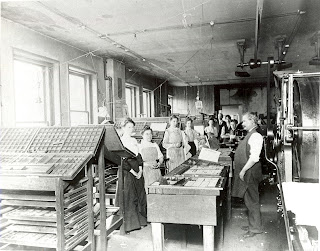In his book Democracy in America (1835), French writer Alexis De Tocqueville noted that there were more newspapers in America than any other country in the world. The earliest papers in what would eventually be Chemung County were The Telegraph and The Vedette, both published in the Village of Newtown (now Elmira) by opposing political parties in the 1810s. These early papers were relatively short, just four pages long, and were printed on paper made from recycled rags. They were produced on a flat-bed press which could only print one side at a time. Although the names of the local papers changed, for much of the 1800s, Chemung County’s papers were all printed in basically the same way.
 |
| Issues of The Telegraph (1816) and The Vedette (1819) published in the Village of Newtown |
Then came a technological revolution. In 1843, Richard March Hoe invented the rotary press. In a flat-bed press, single sheets of paper were mechanically pressed against the engraving plates. In a rotary press, a continuous roll of paper ran over an imprinting cylinder. Rather than make a new cylinder for each image, printers used thin metal or papier-mâché moulds called stereotypes wrapped around the cylinder for each new page. A subsequent improvement to the design of the press by Robert Barclay in 1875, allowed pages to be printed double-sided. The new press was called a rotary or web offset printer. Versions of this press are still widely used in the newspaper industry today.
 |
| How a rotary offset printer works |
 |
| Elmira Telegram press, 1902 |
 |
| papier-mâché stereotype from the Elmira Evening Star, 1901 |
The second major
revolution came in the way the type was set.
Since the days of Gutenberg, type had been set by hand. The sheer amount of time required for
typesetting meant that no daily paper in the world was longer than eight
pages. Then, in 1884, the Linotype
machine automated the way that type was set.
All the operator had to do was type in the special 90-key keyboard and
the type would set itself. The process
was widely adopted by the newspaper publishing industry and was still in use
through the 1960s.
 |
| Manual typestters at The Defender, ca. 1900 |
 | ||
| Typesetters from Star-Gazette on Linotype machines, 1908
|

Possessing newspapers from Newtown is a great thing for the Society! Mark Twain went broke backing the wrong inventor of the line-o'-type machine; there were apparently quite a number of competitors. Thanks for this summary.
ReplyDeleteAnother terrific post! Thank you this is great!
ReplyDeleteinteresting how newspapers of the past coming into our current time in history and how they were made, with what and how some of the same techniques are used today!!
ReplyDelete